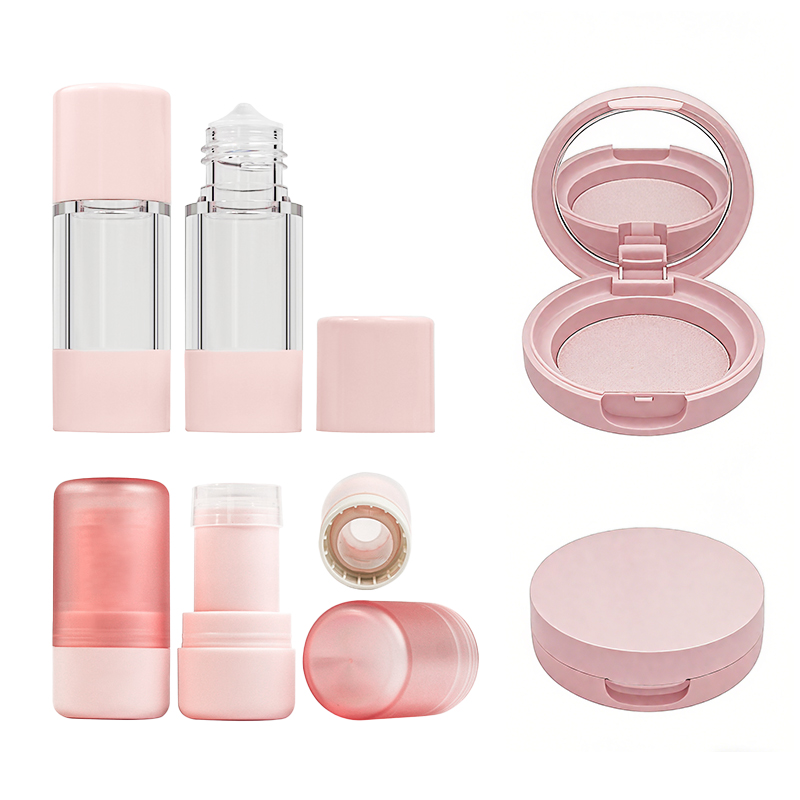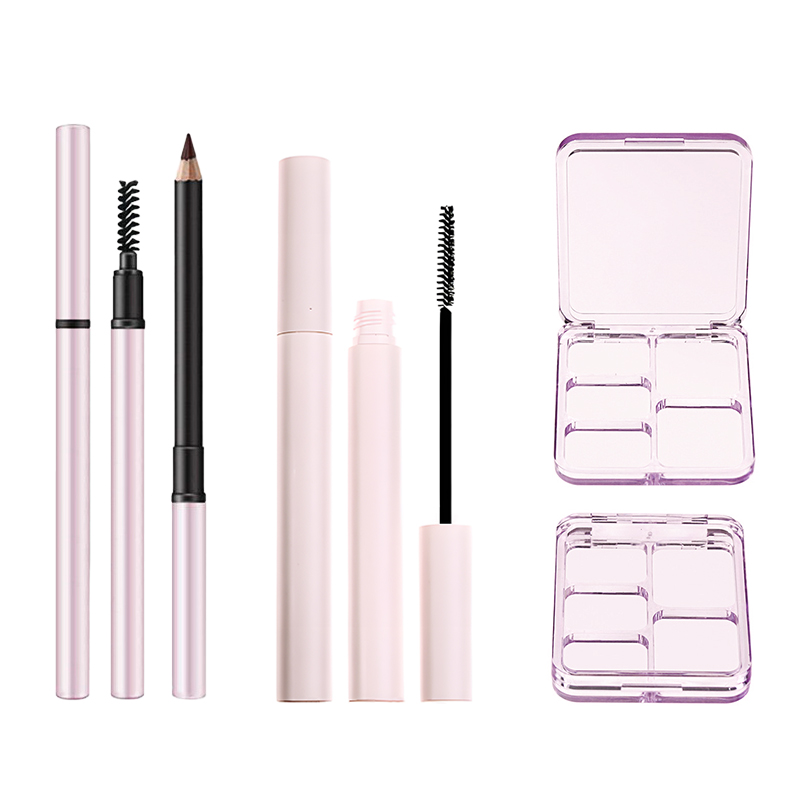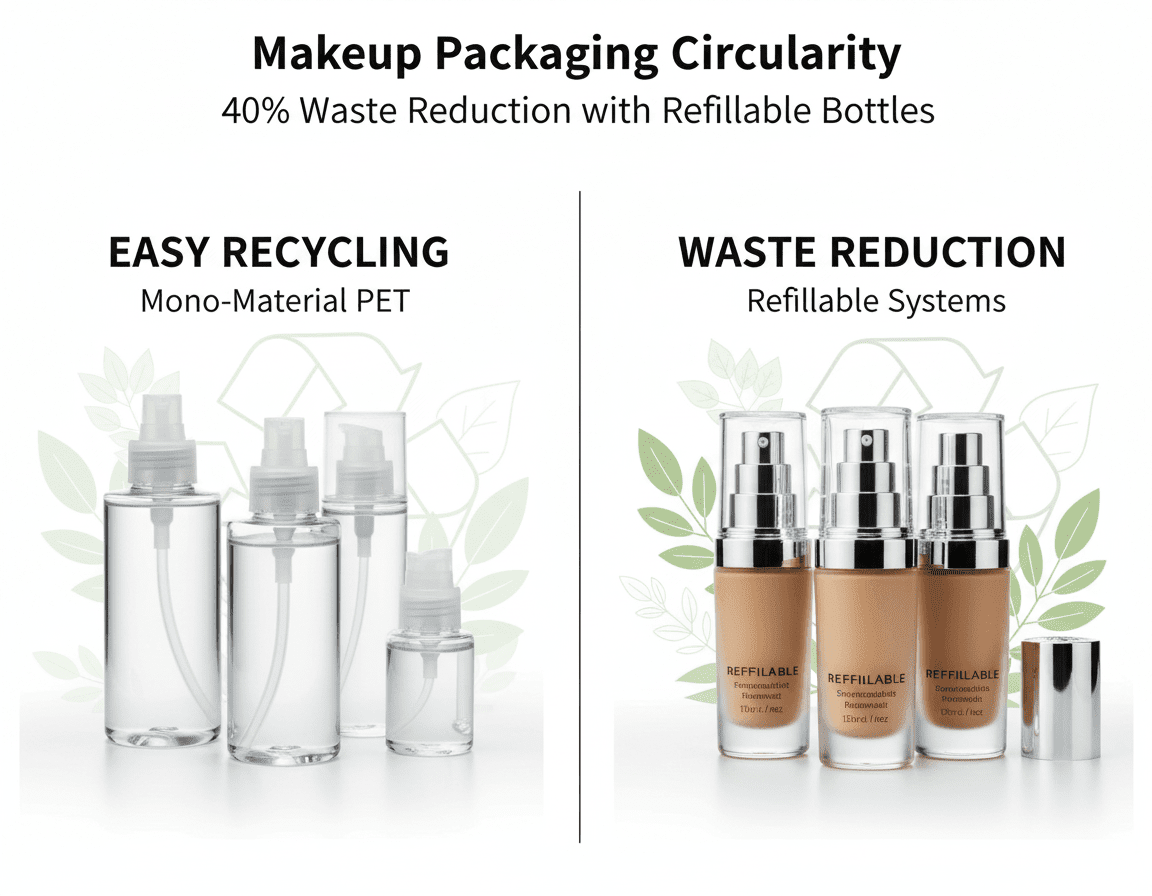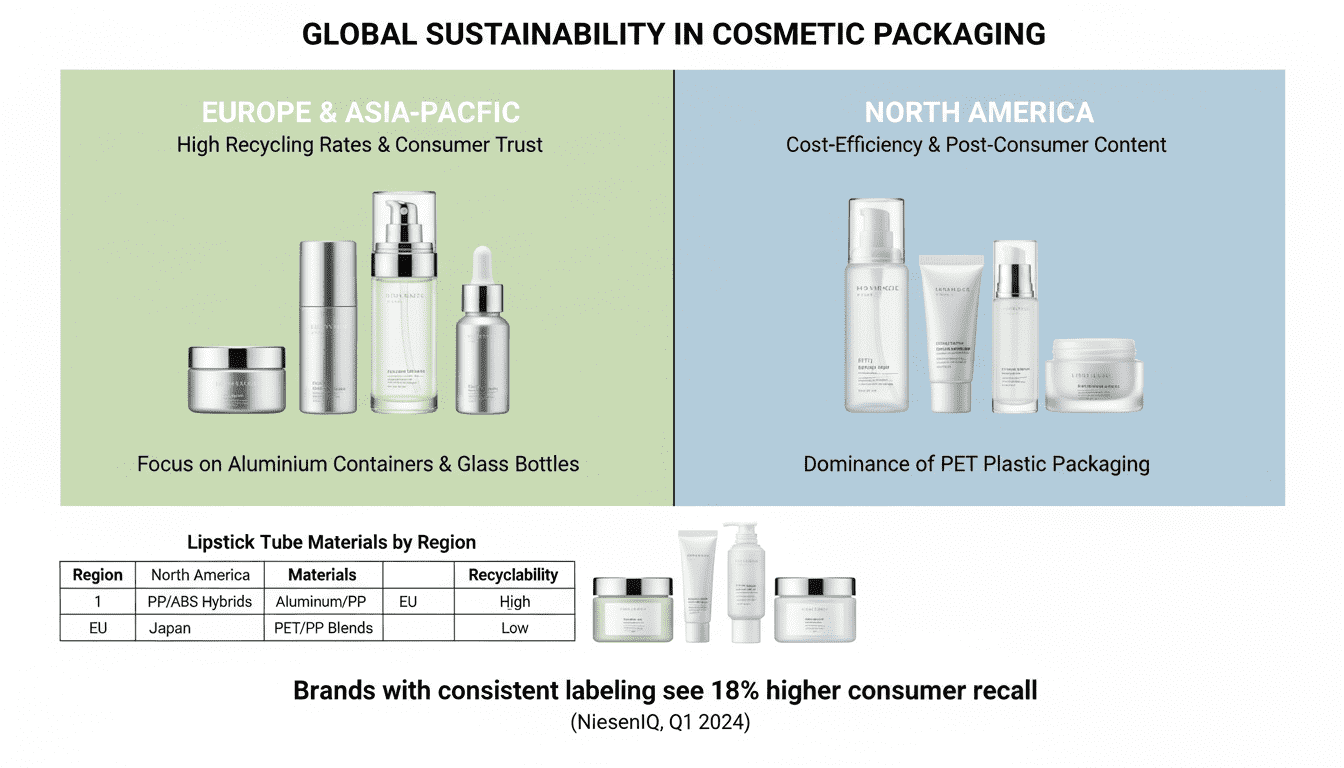New Insights into Makeup Packaging Companies’ Sustainable Plans
You ever notice how your bathroom drawer starts to look like a graveyard of half-used compacts and empties that can’t be recycled? Makeup packaging companies are catching on—fast. Turns out, customers want their lipstick tubes as clean in conscience as they are in color.
“In some markets, refillable foundation bottles have cut packaging waste by nearly 40%,” says Lin Wei, senior design lead at Topfeel Packaging (2024). That’s not just eco brownie points—it’s cost savings and brand loyalty rolled into one sleek pump. (Euromonitor)
Think mono-material PET that actually gets recycled. Think matte-black aluminum cases that scream luxury but still go curbside. Beauty brands aren’t just switching it up—they’re getting sharp about what buyers care about: sustainable style with global consistency. (berlinpackaging.com)
So… is your supplier still stuck in 2015? Or ready for the future where mascara wands don’t outlive us all?
Reading Notes for a Greener Tomorrow: How Makeup Packaging Companies Are Designing Waste Out
➔ Biodegradable Plastics Rise Up: Compostable materials are now the new normal, aligning with eco-conscious customer demand and reducing landfill impact. (ScienceDirect)
➔ Refillables = Repeat Customers: Refillable foundation bottles cut down packaging waste by up to 40%, while boosting brand loyalty through repeat purchases. (Euromonitor)
➔ Mono-Material Magic: PET plastic in single-material formats simplifies recycling, making circular packaging systems more effective and scalable. (berlinpackaging.com)
➔ Luxury Meets Sustainability: Matte black aluminum containers bring premium appeal to limited editions—without compromising recyclability or style. (international-aluminium.org)
➔ Global Consistency Wins: Seamless label application and standardized material adoption across regions help makeup packaging companies scale sustainably. (labelmaterials.upm.com)
Future Of Sustainable Materials In Makeup Packaging Companies
With eco-hype growing louder, brands are rethinking every bottle and tube. Here’s how material choices are reshaping the beauty shelf.
Why are biodegradable plastics the new standard for makeup packaging?
- Biodegradable plastics break down faster than traditional options, easing landfill stress.
- They’re plant-based, often made from corn starch or sugarcane.
- Compostable variants offer a guilt-free toss after use. (ScienceDirect)
- Consumers now expect green packaging to match their clean formulas. (McKinsey & Company)
- Regulations around plastic waste are tightening globally. (Consilium)
- Brands using these materials get an eco-badge of honor in customer eyes.
✦ Bioplastics don’t just look good—they do good too.
As beauty buyers grow more ingredient-savvy, they’re also scrutinizing containers. Makeup packaging that’s biodegradable isn’t just trendy—it’s becoming table stakes in the sustainability game.
Short shelf life? Sure—but that’s the point. These materials live fast and decompose young, unlike petroleum-based counterparts that linger for centuries.
More and more makeup companies are switching to biopolymers not just for compliance, but because it aligns with their values—and their customers’. (ScienceDirect)
Custom Pantone cardboard lipstick tubes
• Custom shades mean brand recognition at a glance—no label reading needed. • Cardboard is lightweight and recyclable, making it a top pick for greener shipping. • It stands out on shelves crowded with plastic sameness.
- Choose a signature hue using Custom Pantone matching.
- Wrap it in sturdy yet stylish cardboard, ditching plastic without losing appeal. (If your line includes glosses, consider pairing with recyclable lip gloss tubes to keep materials consistent.)
♻ Sleek design meets sustainability—who says you can’t have both?
These lipstick tubes aren’t just about color—they tell your brand story before the cap even comes off. Eco-conscious shoppers notice when you go all-in on sustainable packaging without compromising aesthetics or function.
Want to shout luxury while staying low-impact? This is where smart branding meets smart materials—and Topfeel is already ahead of the curve on this one. (Explore more in Sustainable Cosmetic Packaging.)
PET plastic, acrylic plastic, glass bottles: ranking sustainable potential
Grouped by recyclability:
♻️ High: Glass bottles
- Reusable
- Infinitely recyclable
- Non-toxic during breakdown
⚠️ Medium: PET plastic
- Widely recycled but still fossil-fuel based
- Lightweight = lower transport emissions
🚫 Low: Acrylic plastic
- Rarely accepted in curbside programs
- Long degradation period (feve.org)
Each has its pros and cons—but if we’re talking long-term planet perks, glass wins hands-down thanks to its circular lifecycle and zero microplastic concerns. (feve.org)
Still, many beauty brands juggle between cost, weight, and appearance when choosing among these three for their product lines—especially smaller-scale indie labels trying to make green moves without breaking budgets.
Limited edition launches drive the shift to matte black aluminum containers
Exclusive drops need exclusive looks—enter sleek matte finishes.
Premium feel + full recyclability = win-win for limited runs.
Aluminum resists corrosion and protects formulas better than most plastics. (allure.com)
- Launch hype builds fast when products look high-end before they’re even opened.
- Collectors love reusable designs like refillable tins or twist-up sticks made from durable metal alloys like matte black aluminum.
- Sustainable doesn’t have to mean boring—these containers prove it every time they hit shelves.
Limited editions aren’t just marketing stunts anymore—they’re test beds for innovation in materials too. And when consumers know they’re getting something rare and responsibly packaged? That’s double brownie points with today’s eco-aware audience looking beyond just what’s inside the bottle from modern-day makeup makers.
Five Steps Makeup Packaging Companies Take To Implement Circular Models
Circularity isn’t just a buzzword anymore—it’s a playbook. Here’s how packaging makers are stepping up their game for cleaner, smarter beauty.
Confused by mixed materials? Mono-material PET plastic for easy recycling
When it comes to sustainable packaging, mixed materials are a major headache—hard to sort, harder to recycle. That’s where mono-material solutions like PET come in clutch.
• By using only one type of plastic, recycling becomes more efficient and less contaminated. • Brands are ditching complex combos in favor of clean, single-substance builds that flow straight into the circular economy. • It also helps with sorting tech at recycling plants—machines love consistency. (berlinpackaging.com)
In short, simplifying your material choices can mean the difference between landfill and loop.
Data shows refillable foundation bottles reduce waste by 40%
Refillables aren’t just trendy—they’re doing serious environmental work behind the scenes.
Industry analysis shows that switching to refillable formats reduces packaging waste and raw material use, especially when paired with drop-in cartridges or snap-lock refills. (Euromonitor)
Less raw material use, fewer emissions during transport, and longer product lifecycles all add up fast when scaled across multiple product lines by leading makeup firms.
Can compostable eco-friendly cardboard eyeshadow palettes meet luxury standards?
Eco doesn’t have to mean boring—and these new-gen palettes prove it:
• Made from fully compostable, FSC-certified cardboard that breaks down naturally over time • Designed with luxe finishes like foil accents and embossed textures without compromising recyclability • Compatible with magnetic pan inserts for easy shade swaps and reduced waste • Lightweight yet sturdy enough to survive daily use without cracking or fraying (ScienceDirect)
These innovations let brands keep their premium edge while sticking to their sustainability goals—no trade-offs required. (For refillable color systems, pair with empty eye palette options to keep SKUs flexible.)
Hot stamping and UV coating on aluminum containers
- Many makeup brands now opt for aluminum containers, thanks to their infinite recyclability.
- To maintain shelf appeal without harming recyclability, they use decorative techniques like:
- Hot stamping, which adds reflective detail without extra layers
- And selective UV coating, which enhances shine without interfering with post-use processing (allure.com)
- These finishing touches elevate the look while keeping things firmly within a circular design ethos.
- Plus, aluminum’s durability means these packages often get reused before they’re even recycled—a win-win scenario that’s hard to beat. (international-aluminium.org)
The rising trend of spray pumps and sifter jars in circular packaging
Circular thinking is reshaping how products are dispensed—and two formats are leading the charge:
Spray pumps are being reengineered with mono-material parts or removable springs so they’re easier to disassemble after use. Meanwhile, modern sifter jars now feature screw-top lids made from recyclable PP plastics or reusable glass bases that can be refilled again and again. (If you sell loose powders, consider pairing with a reusable powder container to keep the whole kit circular.) (Recycling Today)
What makes them stand out isn’t just their function—but how they fit into broader reuse cycles adopted by many makeup producers today. The combo of smart design + user convenience is what keeps these components flying off production lines across sustainable beauty brands worldwide—even Topfeel has dipped its toes into this format recently.
Global Expansion: Sustainable Packaging Rollout
Quick wins in sustainable packaging don’t cut it anymore. Brands are scaling globally, and that means smarter, cleaner materials and design choices across borders.
Global markets: aluminum containers, glass bottles, PET plastic adoption rates
- Aluminum containers are gaining serious traction in Europe thanks to high recycling rates and consumer trust.
- Glass bottles, while heavier, remain popular in premium segments across Asia-Pacific for their luxe feel.
- PET plastic, especially the recycled kind (rPET), dominates North America due to lightweight cost-efficiency. (ecocaps.com)
- Europe – Aluminum boom driven by urban recycling programs.
- North America – PET still rules but shifting toward post-consumer content.
- Asia-Pacific – Glass holds prestige; sustainability messaging is catching up fast.
♻️ Adoption patterns often mirror local waste management systems more than brand preferences.
In short—if you’re not aligning with regional material trends, you’re missing the mark. For example, some makeup packaging companies still push PET in markets where glass is a status symbol—big miss.
Lipstick Tubes vs. Mascara Containers
| Region | Preferred Material | Recyclability Rating | Mono-material Use |
|---|---|---|---|
| North America | PP/ABS hybrids | Medium | Low |
| EU | Aluminum/PP | High | Medium |
| Japan | PET/PP blends | Low | Low |
Lipsticks and mascaras may look small but they pack complex challenges:
• Lipstick tubes, when made from mono-materials like PP or aluminum shells, are easier to recycle—but only if disassembly is intuitive. (For cartridge systems, consider custom PP heart lipstick case to keep components in one polymer family.) • Mascara containers, on the other hand, often include mixed plastics and wands that complicate things. (Explore mascara tubes engineered for simpler end-of-life sorting.) (berlinpackaging.com)
Short answer? Simplify designs. A few packaging suppliers are already making the shift—Topfeel being one of them—by developing refillable lipstick cartridges using single polymers.
Seamless label application across global cosmetics lines
Consistent labeling isn’t just aesthetics—it protects performance and recall while avoiding waste from failed adhesion. In humid climates like Southeast Asia, adhesives need special formulations to prevent peeling on glass bottles or condensation-prone aluminum containers; in colder regions, labels can shrink or crack unless tested for flexibility over time. NielsenIQ’s BASES research also shows optimized package design can lift forecasted revenue, underscoring the business case for getting labels right. (label.averydennison.com)
Several cosmetic container makers now offer modular labeling solutions tailored per climate zone while maintaining visual uniformity—key for brand trust and sustainability goals alike. (If you’re updating packaging graphics, audit both materials and inks through custom cosmetic packaging best practices.)
References
- Beauty & Personal Care Packaging: Key Trends & Innovations — Euromonitor – https://www.euromonitor.com/beauty-and-personal-care-packaging-key-trends-and-innovations/report
- Sustainability Claims Unpacked: Rethinking Refill — Euromonitor (Jun 26, 2025) – https://www.euromonitor.com/article/sustainability-claims-unpacked-rethinking-refill
- Mono-Material Packaging: Simplifying the Recycling Process — Berlin Packaging – https://www.berlinpackaging.com/insights/sustainability/mono-material-packaging-simplifies-the-recycling-process
- Mono-materials answer the call for “recycle-ready” packages — Beauty Packaging – https://www.beautypackaging.com/mono-materials-answer-the-call-for-recycle-ready-packages/
- Aluminum Association — Recycling & Sustainability – https://www.aluminum.org/Recycling
- International Aluminium Institute — Aluminium is Infinitely Recyclable – https://international-aluminium.org/landing/aluminium-is-infinitely-recyclable/
- FEVE — Is glass a sustainable material? – https://feve.org/about-glass/sustainable-material/
- Glass Packaging Institute — Facts About Glass Recycling – https://www.gpi.org/facts-about-glass-recycling
- O-I Glass — The Most Sustainable Package – https://www.o-i.com/sustainability/the-most-sustainable-product/
- NAPCOR — 2023 US PET Bottle Recycling Rate – https://napcor.com/news/2023-pet-bottle-recycling-reach-new-heights/
- APR Design® Guide for Plastics Recyclability (PDF) — Association of Plastic Recyclers – https://fortissolutionsgroup.com/wp-content/uploads/2019/12/Full_APR_Design_Guide.pdf
- APR recognizes plastic dispensers — Recycling Today – https://www.recyclingtoday.com/news/apr-mpg-plastic-dispensers/
- P&G patents completely recyclable product pump — CosmeticsDesign – https://www.cosmeticsdesign.com/Article/2023/01/23/p-g-patents-completely-recyclable-product-pump/
- Mono-material airless pump unlocks beauty recycling — BeautyMatter – https://beautymatter.com/articles/mono-material-airless-pump-unlocks-beauty-recycling-challenges
- PPWR — Council of the EU press release (Dec 16, 2024) – https://www.consilium.europa.eu/en/press/press-releases/2024/12/16/sustainable-packaging-council-signs-off-on-new-rules-for-less-waste-and-more-re-use-in-the-eu/
- Cosmetic plastic packaging recyclability guide (2025) — ELIPSO & FEBEA (PDF) – https://www.febea.fr/sites/default/files/2025-04/ELIPSO-FEBEA-Guide%20sur%20la%20recyclabilite%20des%20emballages%20cosmetiques%20plastiques_2025-EN.pdf
- Avery Dennison — Labeling cold/wet bottles (PDF) – https://label.averydennison.com/content/dam/averydennison/lpm-responsive/na/doc/technical-bulletins/technical%20marketing%20bulletins/z3338-technical-bulletin.pdf
- UPM Raflatac — Cosmetic label selection guide – https://www.labelmaterials.upm.com/labels-by-industry/cosmetic-labels/personal-care-label-selection-guide/
- NielsenIQ BASES — Role of packaging design (Oct 29, 2021) – https://nielseniq.com/global/en/insights/education/2021/from-conscious-to-non-conscious-understanding-the-role-of-packaging-design/
- Allure — Aluminum packaging trend report – https://www.allure.com/story/aluminum-packaging-trend-report
FAQs
Mono-material PET is changing the game for sustainable beauty. By sticking to a single type of plastic, it avoids the messy business of separating components during recycling. That means less contamination and more material actually making it through the system. It’s a quiet but powerful shift—streamlining how products come full circle. (See Sustainable Cosmetic Packaging for examples.)
- Simplifies post-use sorting, boosting recycling rates
- Cuts down on waste that ends up in landfills
- Supports brands aiming for closed-loop systems
-
Refills can cut packaging waste over time
-
Encourage loyalty through eco-conscious design choices
-







